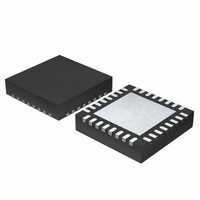ISL6568CR-T Intersil, ISL6568CR-T Datasheet - Page 11

ISL6568CR-T
Manufacturer Part Number
ISL6568CR-T
Description
IC CTRLR PWM BUCK 2PHASE 32-QFN
Manufacturer
Intersil
Datasheet
1.ISL6568CRZ-TR5184.pdf
(29 pages)
Specifications of ISL6568CR-T
Applications
Controller, Intel VRM9, VRM10, and AMD Hammer Applications
Voltage - Input
3 ~ 12 V
Number Of Outputs
1
Voltage - Output
0.84 ~ 1.6 V
Operating Temperature
0°C ~ 70°C
Mounting Type
Surface Mount
Package / Case
32-VQFN Exposed Pad, 32-HVQFN, 32-SQFN, 32-DHVQFN
Lead Free Status / RoHS Status
Contains lead / RoHS non-compliant
pulse termination signal is the inverse of the switching
frequency set by the resistor between the FS pin and
ground. Each cycle begins when the clock signal commands
PWM1 to go low. The PWM1 transition signals the internal
channel-1 MOSFET driver to turn off the channel-1 upper
MOSFET and turn on the channel-1 synchronous MOSFET.
In the default channel configuration, the PWM2 pulse
terminates 1/2 of a cycle after the PWM1 pulse.
If the BOOT2 and PHASE2 pins are both connected to +12V
single channel operation is selected.
Once a PWM pulse transitions low, it is held low for a
minimum of 1/3 cycle. This forced off time is required to
ensure an accurate current sample. Current sensing is
described in the next section. After the forced off time
expires, the PWM output is enabled. The PWM output state
is driven by the position of the error amplifier output signal,
V
sawtooth ramp as illustrated in Figure 3. When the modified
V
transitions high. The internal MOSFET driver detects the
change in state of the PWM signal and turns off the
synchronous MOSFET and turns on the upper MOSFET.
The PWM signal will remain high until the pulse termination
signal marks the beginning of the next cycle by triggering the
PWM signal low.
Channel-Current Balance
One important benefit of multi-phase operation is the thermal
advantage gained by distributing the dissipated heat over
multiple devices and greater area. By doing this the designer
avoids the complexity of driving parallel MOSFETs and the
expense of using expensive heat sinks and exotic magnetic
materials.
In order to realize the thermal advantage, it is important that
each channel in a multi-phase converter be controlled to
carry about the same amount of current at any load level. To
achieve this, the currents through each channel must be
sampled every switching cycle. The sampled currents, I
from each active channel are summed together and divided
by the number of active channels. The resulting cycle
average current, I
current demand on the converter during each switching
cycle. Channel-current balance is achieved by comparing
the sampled current of each channel to the cycle average
current, and making the proper adjustment to each channel
pulse width based on the error. Intersil’s patented current-
balance method is illustrated in Figure 3, with error
correction for channel 1 represented. In the figure, the cycle
average current, I
sample, I
The filtered error signal modifies the pulse width
commanded by V
I
correction is applied to each active channel.
ER
COMP
COMP
toward zero. The same method for error signal
, minus the current correction signal relative to the
voltage crosses the sawtooth ramp, the PWM output
1
, to create an error signal I
COMP
AVG
AVG
, provides a measure of the total load-
, is compared with the channel 1
to correct any unbalance and force
11
ER
.
n
,
ISL6568
ISL6568
Current Sampling
In order to realize proper current-balance, the currents in
each channel must be sampled every switching cycle. This
sampling occurs during the forced off-time, following a PWM
transition low. During this time the current-sense amplifier
uses the ISEN inputs to reproduce a signal proportional to
the inductor current, I
a scaled version of the inductor current. The sample window
opens exactly 1/6 of the switching period, t
PWM transitions low. The sample window then stays open
the rest of the switching cycle until PWM transitions high
again, as illustrated in Figure 4.
The sampled current, at the end of the t
proportional to the inductor current and is held until the next
switching period sample. The sampled current is used only
for channel-current balance.
The ISL6568 supports MOSFET r
sample each channel’s current for channel-current balance.
The internal circuitry, shown in Figure 5 represents channel
n of an N-channel converter. This circuitry is repeated for
each channel in the converter, but may not be active
NOTE: Channel 2 is optional.
FIGURE 3. CHANNEL-1 PWM FUNCTION AND CURRENT-
V
COMP
FILTER
FIGURE 4. SAMPLE AND HOLD TIMING
BALANCE ADJUSTMENT
CURRENT
OLD SAMPLE
+
I
ER
-
+
f(s)
I
1
PWM
L
-
. This sensed current, I
I
AVG
SAWTOOTH SIGNAL
SWITCHING PERIOD
SAMPLING PERIOD
÷ N
I
L
TIME
DS(ON)
I
+
-
SEN
PWM1
SAMPLE
Σ
current sensing to
SW
SEN
, after the
NEW SAMPLE
CURRENT
, is
CONTROL
TO GATE
, is simply
LOGIC
March 9, 2006
I
2
FN9187.4











